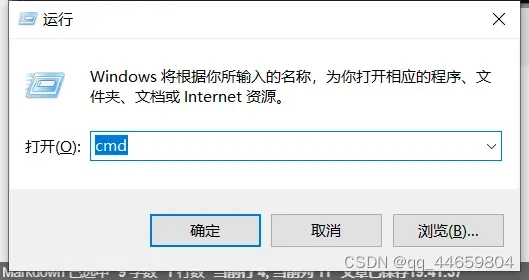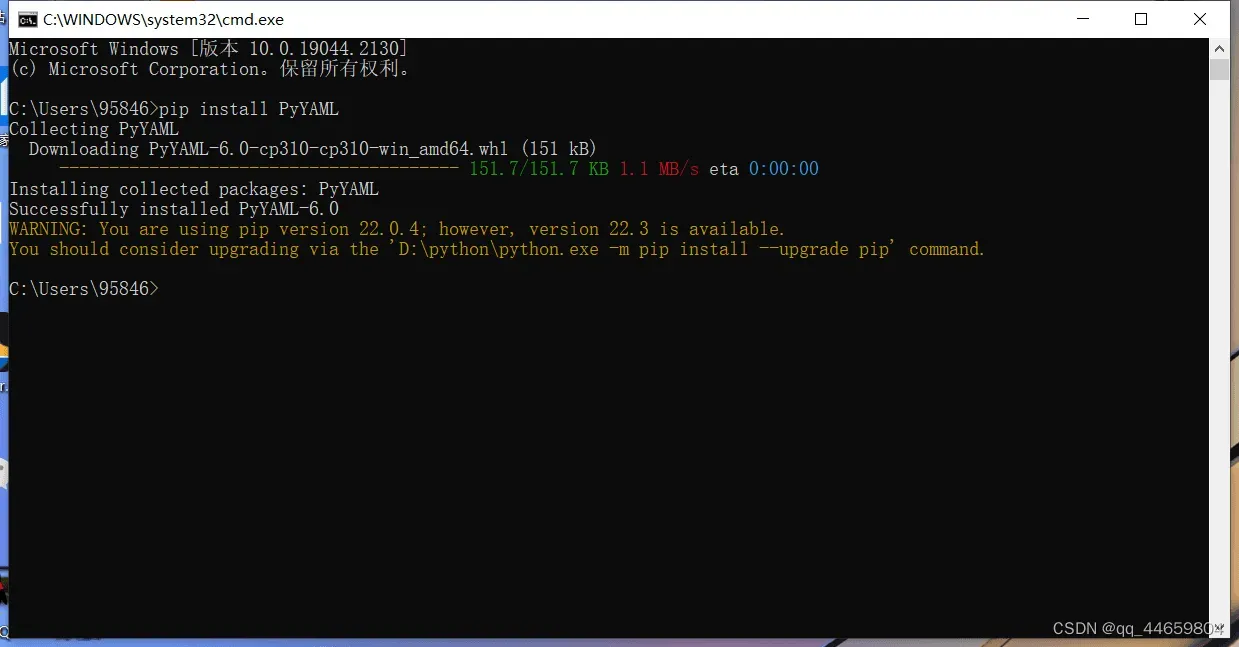安装PyYAML安装包
YAML在python语言中有PyYAML安装包,下载地址:https://pypi.python.org/pypi/PyYAML
联网的windows可直接win+r cmd进入终端pip install PyYAML


配置yaml文件
进入相应python文件的目录,创建yaml文件(略)
通过编程软件创建

自定义文件后缀为 .yaml

编写yaml文件内容
city: shanghai
time: 202210
successfully: 200
exception: 500python读取yaml文件
#使用utf-8编码
# -*- coding:utf-8 -*-
#导入yaml模块
import yaml
f = open('test.yaml', 'r', encoding='utf-8') #读yaml文件,编码用utf-8
cfg = f.read() #读全部文件
d = yaml.load(cfg, Loader=yaml.FullLoader) # 用load方法把读到的yaml文件内容转换成字典类型
# yaml5.1版本后弃用了yaml.load(file)这个用法,因为觉得很不安全,5.1版本之后就修改了需要指定Loader,通过默认加载器(FullLoader)禁止执行任意函数
# Loader=yaml.FullLoader 加上这行代码,告警就没了
print(d)结果为字典类型
{‘city’: ‘shanghai’, ‘time’: 202210, ‘successfully’: 200, ‘exception’: 500}
yaml文件与python代码书写比较
yaml基本语法规则:
键值对
大小写敏感
使用缩进表示层级关系
缩进时不允许使用Tab键,只允许使用空格。
缩进的空格数目不重要,只要相同层级的元素左侧对齐即可
#表示注释,从这个字符一直到行尾,都会被解析器忽略,这个和python的注释一样
yaml支持的数据结构有三种:
对象:键值对的集合,又称为映射(mapping)/ 哈希(hashes) / 字典(dictionary)
数组:一组按次序排列的值,又称为序列(sequence) / 列表(list)
纯量(scalars):单个的、不可再分的值。字符串、布尔值、整数、浮点数、Null、时间、日期
字典嵌套字典
#字典嵌套字典
#python代码书写为{'dd': 'city2:shanghai2 time2:2022102'}
#dd:
# city2: shanghai2
# time2: 2022102列表(或叫数组)中嵌套字典,字典中一组数据
#列表(或叫数组)中嵌套字典
#python代码书写为[{'city2': 'shanghai2'}, {'time2': 2022102}, {'successfully': 200}]
#yaml里面写一个列表,前面加一个'-'符号
- city2: shanghai2
- time2: 2022102
- successfully: 200列表(或叫数组)中嵌套字典,字典中多组数据
#列表(或叫数组)中嵌套字典
#python代码书写为[{'city3': 'shanghai3', 'time3': 2022103}, {'city4': 'shanghai4', 'time4': 2022104}, {'city5': 'shanghai5', 'time5': 2022102}]
- city3: shanghai3
time3: 2022103
- city4: shanghai4
time4: 2022104
- city5: shanghai5
time5: 2022102字典嵌套列表
#字典嵌套列表
#python代码书写为{'color1': ['red', 1], 'color2': ['bule', 2], 'color3': ['black', 3]}
color1:
- red
- 1
color2:
- bule
- 2
color3:
- black
- 3组合使用
#组合使用
#python代码书写为{'languages': ['Ruby', 'Perl', 'Python', 'java c++ shell'], 'websites': {'YAML': 'yaml.org', 'Ruby': 'ruby-lang.org', 'Python': 'python.org', 'Perl': 'use.perl.org'}, 'db': {'host': 'xxx', 'port': 3306, 'user': 'shanghai', 'password': 'xxx', 'db_name': 'china', 'db_type': 'mysql'}}
languages:
- Ruby
- Perl
- Python
- java c++ shell
websites:
YAML: yaml.org
Ruby: ruby-lang.org
Python: python.org
Perl: use.perl.org
db:
host: xxx
port: 3306
user: shanghai
password: xxx
db_name: china
db_type: mysql其他类型
#1、数值直接以字面量的形式表示
#number: 202210.010101 #{'number': 202210.010101}
#2、布尔值用true和false表示
#isSet: true #{'isSet': True}
#isSet1: false #{'isSet1': False}
#3、null用~表示
#parent: ~ #{'parent': None}
#4、时间采用 ISO8601 格式。
#time1: 2022-10-10t10:10:10.10-10:00 #{'time1': datetime.datetime(2022, 10, 10, 10, 10, 10, 100000, tzinfo=datetime.timezone(datetime.timedelta(days=-1, seconds=50400)))}
##5、日期采用复合 iso8601 格式的年、月、日表示。
#date: 2022-10-01 #{'date': datetime.date(2022, 10, 1)}
#6、YAML 允许使用两个感叹号,强制转换数据类型,转换成字符串str。
#int_to_str: !!str 123 #{'bool_to_str': '123'}
#bool_to_str: !!str true #{'bool_to_str': 'true'}到此这篇关于python使用yaml格式文件的方法的文章就介绍到这了,更多相关python使用yaml内容请搜索aitechtogether.com以前的文章或继续浏览下面的相关文章希望大家以后多多支持aitechtogether.com!
